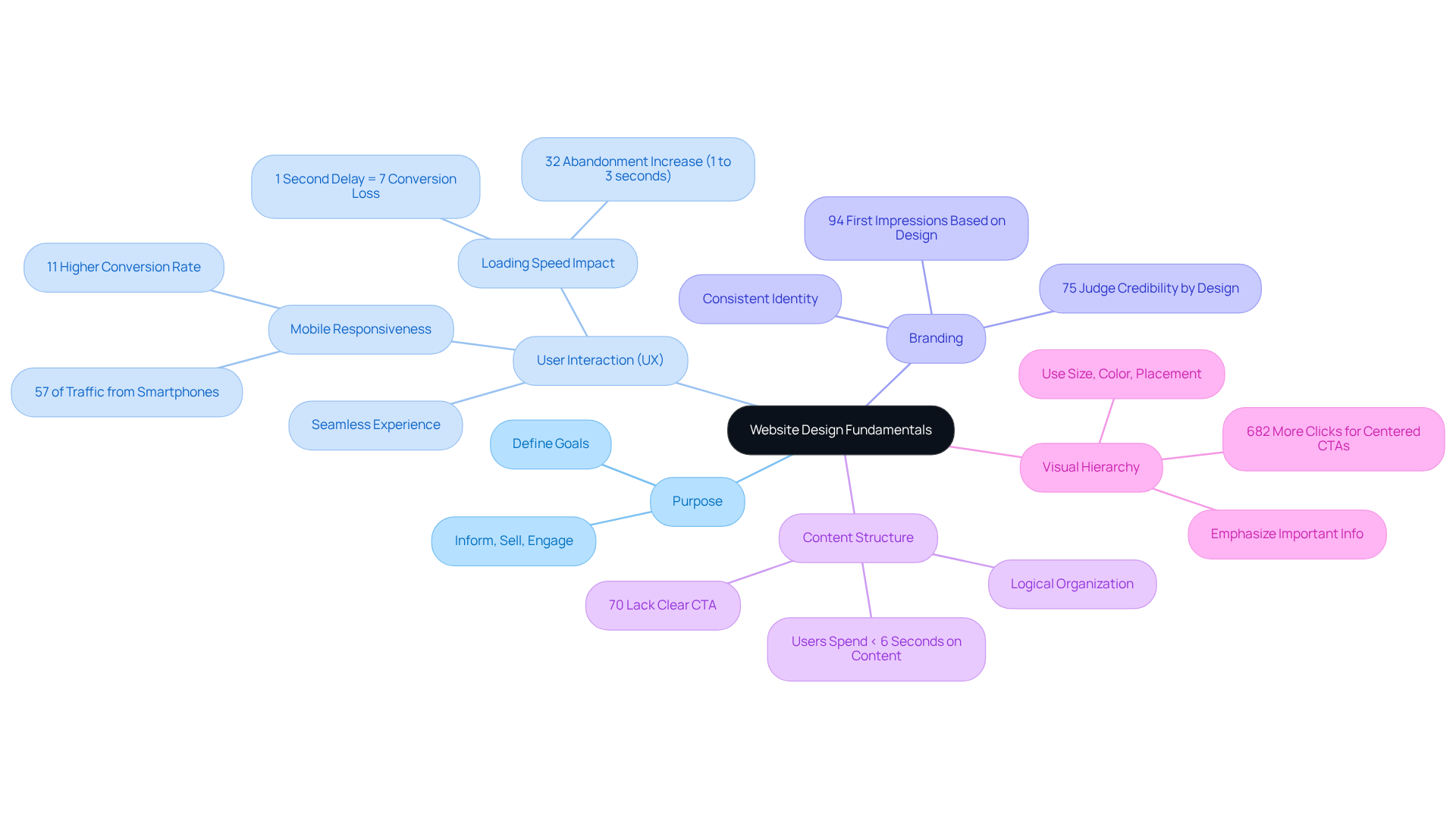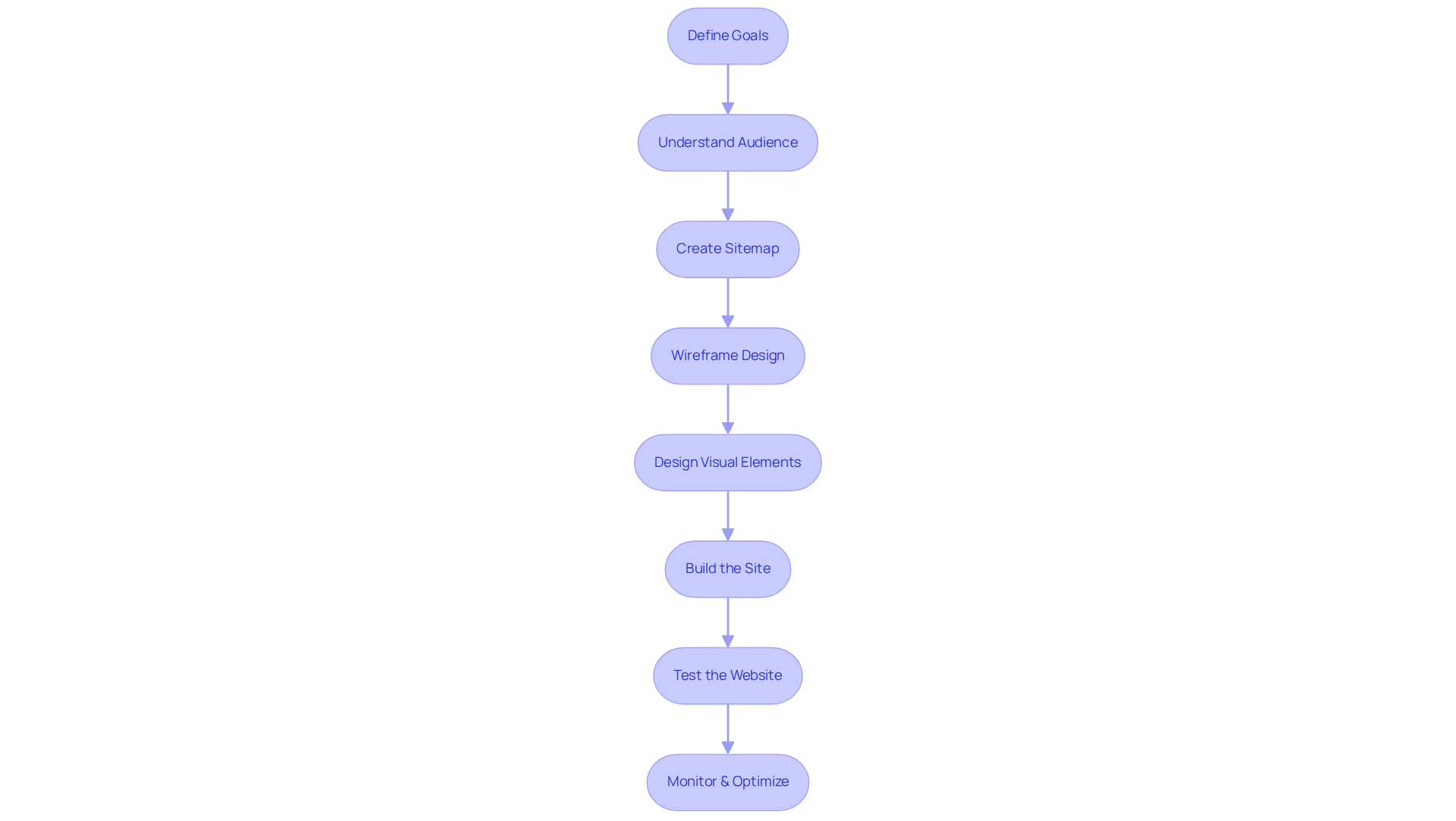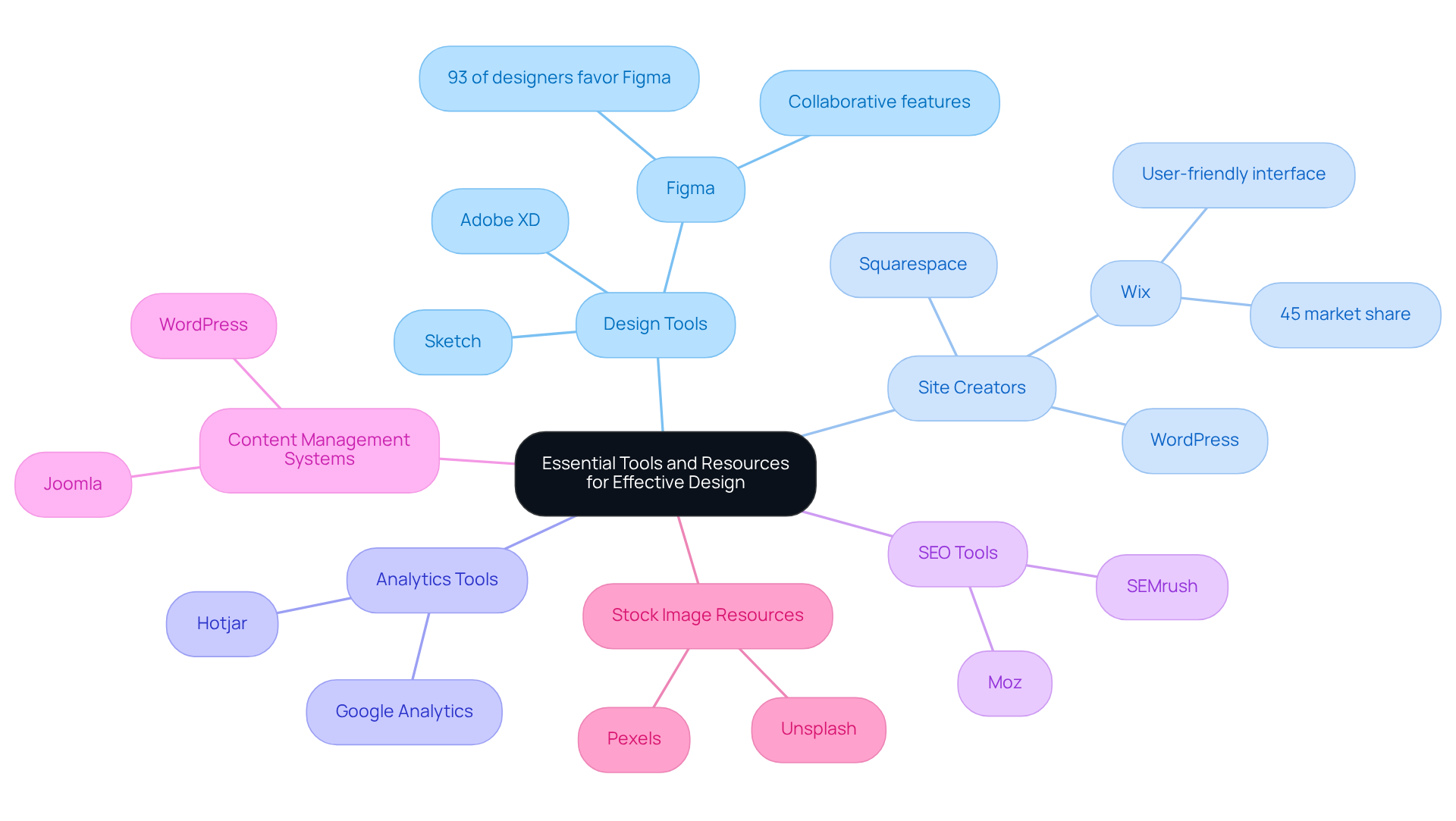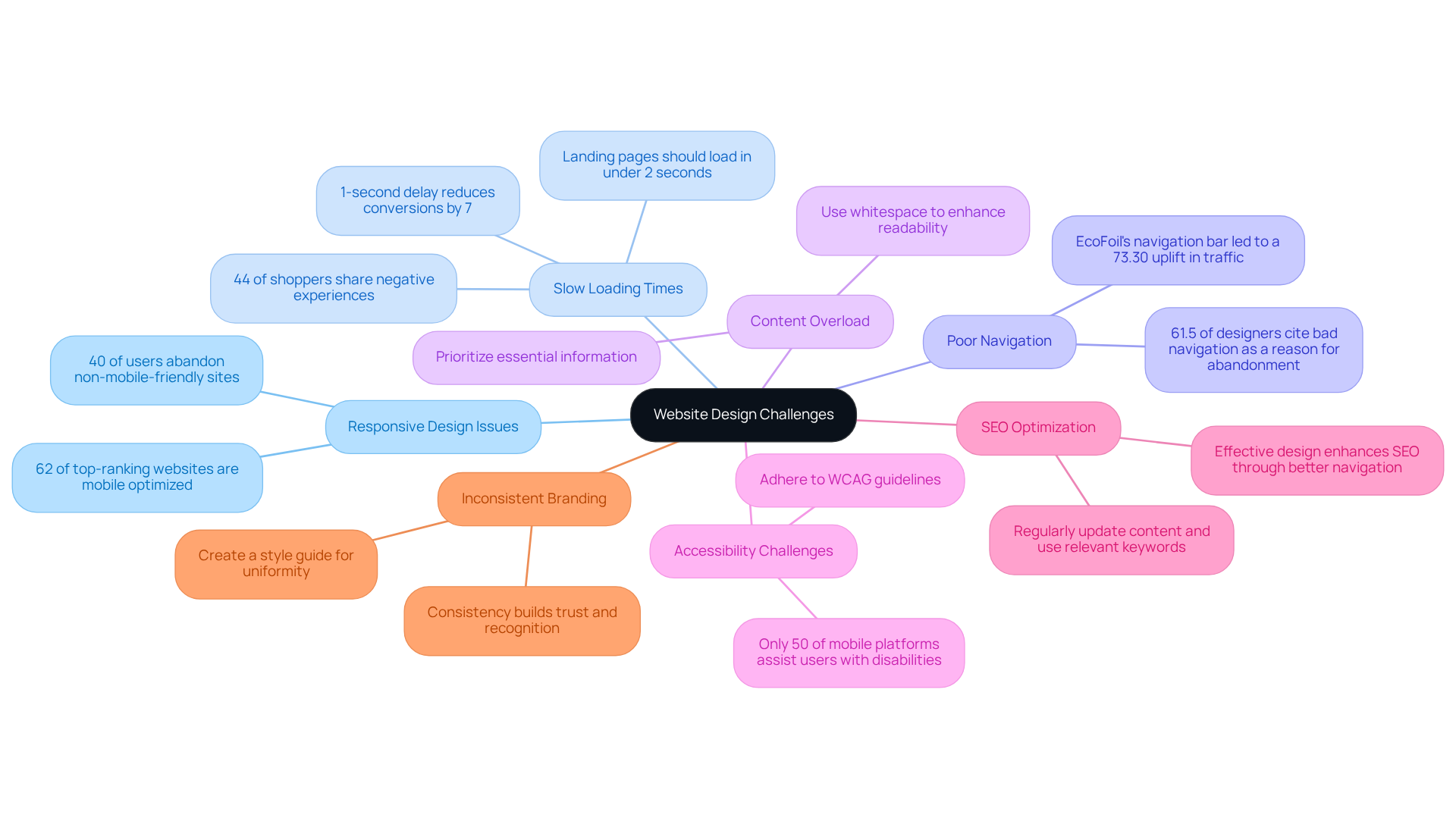Overview
In the journey of launching a tech startup, many founders grapple with the daunting task of mastering the website design process. This challenge can feel overwhelming, especially when trying to define clear goals and understand the nuances of user experience. The emotional toll of navigating these complexities can lead to frustration and uncertainty.
However, it’s essential to recognize that you are not alone in this struggle. Many have faced similar hurdles, feeling the weight of their aspirations while trying to create an engaging online presence. This article aims to provide a supportive solution, offering a comprehensive step-by-step guide tailored for tech startups.
By emphasizing the importance of defining goals and understanding user needs, we can help you navigate this intricate process with confidence. We will explore vital principles such as:
- Mobile responsiveness
- Branding consistency
- Effective troubleshooting strategies
These elements not only enhance user engagement but also foster a successful online presence that reflects your vision.
Together, let’s transform these challenges into opportunities for growth and connection. Your journey is important, and with the right tools and insights, you can create a website that resonates with your audience and elevates your startup’s mission.
Introduction
Creating a successful website can feel like a daunting task for tech startups striving to build a strong online presence. Many founders find themselves grappling not just with the visual aspects of design, but also with functionality and user experience, which can lead to feelings of overwhelm.
It’s important to acknowledge these challenges, as they can weigh heavily on your journey. This guide is here to gently walk you through a comprehensive, step-by-step approach to mastering the website design process. We aim to equip you with the essential tools and strategies that will help you navigate these common hurdles with confidence.
How can startups effectively find harmony between design and usability, crafting a site that not only draws visitors in but also fosters their loyalty as customers? Together, we can explore this path.
Understand the Fundamentals of Website Design
Creating a website goes beyond just looking good; it’s about ensuring it works well for your users. Many founders face the challenge of balancing aesthetics with functionality, which can feel overwhelming. Let’s explore some essential principles that can help you navigate this journey with confidence.
- Purpose: It’s vital to clearly define what you want your website to achieve. Are you aiming to inform, sell, or engage? Understanding this goal shapes your creative decisions and sets the foundation for a successful site.
- User Interaction (UX): Imagine your visitors having a seamless experience. This means intuitive navigation and quick loading times—because even a one-second delay can lead to a 7% drop in conversions. With over 57% of internet traffic coming from smartphones, is non-negotiable. RNO1 focuses on aesthetics that enhance user experience, ensuring every interaction feels tailored and supportive.
- Branding: Your online presence should reflect your brand identity. Consistent colors, fonts, and imagery resonate with your audience and build trust. In fact, 75% of consumers judge a brand’s credibility based on its website. With 94% of first impressions influenced by web design, establishing credibility is crucial. RNO1’s design-driven approach guarantees that your branding is both visually appealing and aligned with your business goals.
- Content Structure: Organizing your content logically can significantly enhance engagement. Use headings, subheadings, and bullet points to make your site more readable, especially since users often spend less than six seconds on written content. Remember, 70% of small business websites lack a clear call to action (CTA) on their homepage, highlighting the need for effective CTAs to guide your visitors.
- Visual Hierarchy: Directing attention through visual hierarchy is key. Use size, color, and placement to emphasize important information, ensuring that your CTAs stand out. For example, center-aligned CTAs can attract 682% more clicks than those aligned to the left.
By mastering these fundamentals, you lay a solid groundwork for your design process, enhancing user experience and engagement. As Jeanette Godreau wisely notes, integrating regular updates into your weekly routine is essential for keeping your online platform performing at its best and relevant in today’s fast-paced environment. Remember, you’re not alone in this journey; RNO1 is here to support you every step of the way.

Follow a Step-by-Step Website Design Process
Creating an effective website can feel overwhelming, but you’re not alone in this journey. Many founders share the struggle of defining clear goals. It’s essential to pinpoint what you want to achieve—whether that’s increasing sales, generating leads, or enhancing brand awareness. By setting specific, measurable goals, you can track your success and feel a sense of accomplishment along the way.
Understanding your audience is another vital step. Have you ever noticed how frustrating slow loading times can be? Statistics show that 88.5% of users leave a mobile site due to this issue. This highlights the importance of a user-focused approach. Engaging in audience research not only informs your design but also helps you connect with your users on a deeper level.
Next, consider creating a sitemap. This outline of your site’s structure—main pages, subpages, and navigation paths—can significantly enhance visitor experience. A well-organized sitemap helps users find information quickly, alleviating any frustration they might feel.
When it comes to wireframing your design, think of it as sketching out your vision. This basic layout allows you to visualize where elements will go without getting lost in the details. It’s a crucial step for ensuring logical flow and user-friendly navigation, making it easier for your visitors to engage with your content.
As you design the visual elements, remember that colors, fonts, and images should reflect your brand identity. Did you know that effective use of color can increase readership by 40% and comprehension by 73%? High-quality visuals are not just attractive; they’re essential. In fact, 40% of users consider images vital on commercial platforms, underscoring their importance.
Now, it’s time to bring your site to life. Whether you choose a site builder or coding, ensure your site is responsive. With mobile devices accounting for over 50% of web traffic, a can lead to a remarkable 40% increase in conversion rates.
Before launching, take the time to test your website rigorously. Gather feedback to identify areas for improvement. A platform that prioritizes outstanding client interaction can achieve a visit-to-lead conversion rate that’s over 400% higher than a poorly designed site. It’s all about creating a seamless experience for your users.
Finally, once your site is live, monitor and optimize it continuously. Utilizing analytics tools allows you to observe user behavior and make necessary enhancements. Investing in customer experience can yield significant returns; studies indicate that every dollar spent on UX can return $100 in revenue. Regular monitoring empowers you to adapt to changing user needs and enhance overall performance.
Remember, building a website is a journey, and you have the support of a community that understands the challenges you face. Embrace the process, and know that each step brings you closer to your goals.

Utilize Essential Tools and Resources for Effective Design
Many founders face the daunting task of navigating numerous tools and resources to streamline the website designing process. This challenge can often feel overwhelming, especially when trying to create a strong online presence. However, with the right tools, you can simplify the website designing process and create a more effective design workflow.
Design Tools: Consider using Figma, Adobe XD, or Sketch for crafting wireframes and prototypes. Figma, in particular, is favored by 93% of designers for its collaborative features. This allows for seamless revisions and teamwork, which are crucial for nurturing effective design workflows in the website designing process that resonate with your vision.
Site Creators: Platforms such as WordPress, Wix, and Squarespace present user-friendly interfaces that empower startups to establish their online presence without needing extensive coding knowledge. Wix stands out with a 45% market share, recognized as the . This makes it an ideal choice for startups eager to create an online presence swiftly and effectively.
Analytics Tools: Google Analytics and Hotjar are invaluable for tracking visitor behavior and gathering insights on interactions. With over 40% of online traffic to small business platforms originating from mobile devices, understanding this data is essential. It enables startups to make informed choices that enhance user experience and engagement, ultimately fostering a deeper connection with your audience.
SEO Tools: Tools like SEMrush and Moz are instrumental in enhancing your online visibility for search engines. This is vital for increasing traffic and ensuring your message reaches those who need it. Notably, 72% of small enterprises recognize the importance of maintaining an online presence, underscoring the need for effective SEO strategies to support your growth.
Content Management Systems (CMS): A CMS like WordPress or Joomla simplifies content updates and management. This ensures your site remains fresh and relevant, which is particularly significant as 73% of small businesses in the U.S. had an online presence as of 2023. In such a competitive landscape, staying current is essential.
Stock Image Resources: Platforms such as Unsplash and Pexels offer high-quality images that can elevate your site's visual appeal without the need for a photographer. Engaging visuals are crucial; users spend 88% more time on sites featuring video content compared to those without. This increased engagement can significantly enhance your connection with visitors.
By utilizing these tools, you can efficiently simplify your creative process and improve the website designing process to develop influential online platforms that resonate with your target audience. Remember, you're not alone in this journey; many founders share similar challenges, and together, we can navigate the path to success.

Troubleshoot Common Website Design Challenges
Navigating the website designing process can be daunting, and many face common challenges that can feel overwhelming. Let's explore these issues together, acknowledging their impact and discovering nurturing solutions that can help you thrive.
Responsive Design Issues: It’s crucial to ensure your platform is mobile-friendly, as a staggering 62% of top-ranking websites are optimized for mobile. Testing your site on various devices can help identify layout problems that may frustrate users. Remember, you’re not alone in this; many have faced similar hurdles.
Slow Loading Times: We all know how frustrating it is to wait for a page to load. A mere one-second delay can reduce conversions by 7%. By optimizing images and minimizing code, you can enhance loading speeds. Tools like Google PageSpeed Insights can guide you in analyzing performance. For instance, Vodafone experienced an 8% sales boost after improving their Largest Contentful Paint (LCP) by 31%. You too can see such positive changes by taking small, actionable steps.
Poor Navigation: Have you ever felt lost on a website? Simplifying your navigation menu can help ensure that individuals can easily find what they need. Clear labels and logical categories enhance usability, and it’s worth noting that 61.5% of web designers cite bad navigation as a primary reason for visitor abandonment. Let’s work together to create a more intuitive experience for your users.
Content Overload: In a world overflowing with information, it’s easy to feel overwhelmed. Prioritizing essential information and effectively using whitespace can enhance readability and concentration. This approach not only improves audience engagement but also fosters a more inviting atmosphere.
Accessibility Challenges: Everyone deserves access to your platform, including individuals with disabilities. By adhering to WCAG guidelines, you can greatly enhance usability. Currently, only 50% of mobile platforms fully assist those with disabilities, but you can be part of the change.
SEO Optimization: Regularly updating your content and utilizing relevant keywords is vital for improving search engine rankings. Remember, effective web design can enhance SEO by improving site navigation and speed, leading to better engagement and search rankings. This is an opportunity to connect with your audience on a deeper level.
Inconsistent Branding: Consistency in colors, fonts, and imagery throughout your online presence reinforces your brand identity. Creating a style guide ensures uniformity, which is essential for building trust and recognition among your audience. Let’s create a cohesive experience that reflects your values.
By proactively addressing these challenges, you can significantly enhance the effectiveness of your website and improve the website designing process to benefit user experience. Together, we can work towards , fostering a supportive community that thrives on collaboration and shared success.

Conclusion
Mastering the website design process can feel overwhelming for tech startups striving to carve out a strong online presence. The challenge lies not just in the aesthetics but in understanding the core principles of design—user experience, branding, and content structure. When founders grasp these fundamentals, they can create websites that do more than attract visitors; they can engage them meaningfully. A thoughtfully designed website becomes a powerful ally in achieving specific business objectives, whether that’s boosting sales, generating leads, or enhancing brand awareness.
Throughout this journey, we’ve highlighted key strategies to help navigate the complexities of website design. Establishing clear objectives is crucial, as is conducting thorough audience research and utilizing essential tools. Yet, the path is often fraught with challenges—slow loading times, poor navigation, and inconsistent branding can hinder user experience. By addressing these pain points, startups can significantly enhance their websites, creating spaces that resonate with their target audience and foster genuine connections.
Ultimately, the journey of designing a website is not a one-time task; it’s an ongoing process that requires continuous monitoring and optimization. Embracing this journey not only enhances the effectiveness of the site but also positions startups for greater success in a competitive landscape. It’s vital to remain adaptable and responsive to user needs, ensuring that the website evolves alongside the business. By taking these thoughtful steps, tech startups can thrive in the digital space, crafting impactful online experiences that drive growth and engagement. Remember, you’re not alone in this journey; together, we can navigate the challenges and celebrate the successes.
Frequently Asked Questions
What is the main purpose of creating a website?
The main purpose of creating a website is to clearly define what you want it to achieve, whether that is to inform, sell, or engage your audience.
Why is user interaction (UX) important in website design?
User interaction is important because it ensures visitors have a seamless experience, which includes intuitive navigation and quick loading times. A one-second delay can lead to a 7% drop in conversions, and mobile responsiveness is essential as over 57% of internet traffic comes from smartphones.
How does branding affect a website's credibility?
Branding affects a website's credibility by ensuring that the online presence reflects the brand identity through consistent colors, fonts, and imagery. 75% of consumers judge a brand's credibility based on its website, and 94% of first impressions are influenced by web design.
What is the significance of content structure on a website?
Content structure is significant because organizing content logically enhances engagement. Using headings, subheadings, and bullet points improves readability, and having a clear call to action (CTA) is crucial, as 70% of small business websites lack a CTA on their homepage.
What role does visual hierarchy play in website design?
Visual hierarchy plays a key role by directing attention to important information. Using size, color, and placement can emphasize CTAs, making them more noticeable; for instance, center-aligned CTAs can attract 682% more clicks than those aligned to the left.
How can regular updates impact a website's performance?
Regular updates are essential for keeping an online platform performing at its best and relevant in a fast-paced environment, ensuring that the content remains fresh and engaging for users.




